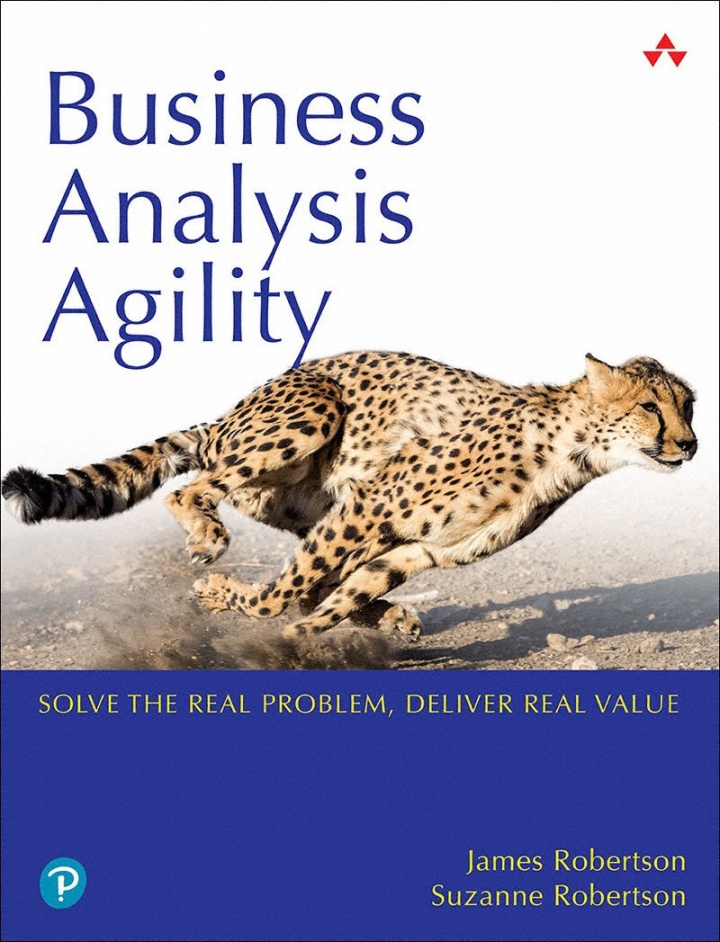
Business Analysis Agility: Delivering Value, Not Just Software, 1st edition
PUBLISHER: PEARSON
eBook edition. 1 Year Subscription. Dành cho Cá nhân | Trường ĐH, Nhóm, Thư Viện: Gọi 0915920514 để báo giá Pearson, Vital Source eBook hoặc mua Sách In
Với tư cách là nhà phát triển, để mang lại giá trị thực, bạn phải hiểu khách hàng của mình thực sự coi trọng điều gì và giải quyết những vấn đề họ thực sự cần giải quyết. Phân tích kinh doanh có thể giúp bạn thực hiện điều này–và nó vẫn quan trọng như mọi khi trong môi trường linh hoạt hiện nay. Trong Phân tích kinh doanh nhanh nhẹn, các chuyên gia hàng đầu James Robertson và Suzanne Robertson chỉ ra cách thực hiện phân tích kinh doanh một cách nhanh nhẹn: thử những điều mới, thích ứng với những thay đổi và khám phá, linh hoạt và nhanh chóng. Dựa trên kinh nghiệm vượt trội của họ trong hàng trăm dự án và tổ chức, Robertsons giúp bạn không ngừng ưu tiên, tập trung đầu tư vào việc mang lại giá trị và học hỏi theo những cách cải thiện kết quả của bạn.Đây là liên kết tới video có thêm thông tin về cuốn sách - https://youtu.be/l_9u5UI12uo
- Foreword xvPreface xixAcknowledgments xxvAbout the Authors xxvii
- Chapter 1: Agile Business Analysis 1Why Is This “agile”? 2Möbius Strip 2Why Are We Concerned with Business Analysis? 3Bernie’s Books–An Example in Agile Business Analysis 4 What Do You Do? 5 What’s Bernie’s Problem? 6 People Assume They Know the Solution 7Analytical Thinking 7Bernie’s Business Goals 8Customer Segments 9 Loyal Customers 9 Twentysomethings 10 Book Cover Bandits 11Value Proposition 11 Who Identifies Customer Segments and Their Value Propositions? 13How Can I Solve the Problem? 13Safe-to-Fail Probes 15 Who Performs Safe-to-Fail Probes? 18Investigate the Solution Space 18 Who Investigates the Solution Space? 20Designing the Solution 20 Who Designs the Solution? 23Opportunities 24Write and Manage Stories 25agile Business Analysis 27Business Analysis for Traditional or Sequential Projects 28The Changing Emphasis of Business Analysis 30
- Chapter 2: Do You Know What Your Customers Value? 33Problem Versus Solution 34Identify the Customer Segments 36 How to Identify the Customer Segments 36 HomeSpace 38 Other Stakeholders 39Prioritize the Customer Segments 39Value Propositions 41Talking to the Customers 43What Impact Will Your Solution Have? 45Business Value 47Is It Risky to Deliver the Value? 47The Moving Target 48Wrong Until Right 49Summary 51
- Chapter 3: Are You Solving the Right Problem? 53The Problem 53Are You Solving the Right Problem? 54 Maslow’s Hierarchy of Needs 56 The Outcome of Solving the Problem 56The Customer’s Needs 57 Customer Journey Maps 58 Travel the Same Journey as Your Customer 60Talking to the Customers 60Uncovering the Essence of the Problem 61 Ask Why Again and Again and Again 62Referred Pain 63Disguised Problems 64The Real Scope of the Problem 66Are You Solving the Problem That You Want to Solve? 68Now You Need a Solution 68 The Solution Is a Hypothesis 69 Off-the-Shelf Solutions 69Options for Solutions 70How Might We? 71 Willingness to Be Creative 72Techniques for Generating Ideas 72 Innovation Triggers 73 Constraint Removal 74 Combining Ideas 75 The Slogan 76Personas 76Portraying Your Solutions 78Safe-to-Fail Probes 78 Right Outcome? 82 “Failed” Probes 83Double Loop 84Outcome and Impact 85Systems Thinking 87Choosing the Best Option 88Summary 89
- Chapter 4: Investigate the Solution Space 91Why Are We Investigating? 92Defining the Scope of the Solution Space 92Business Events 95Scoping by Business Event 97Finding All the Stakeholders 99Investigating the Business Events 101 Prioritize the Business Events 102Using Models for Your Investigation 103 Modeling Business Processes 104Live Modeling 107Business Rules 107Why Don’t I Skip Analysis and Just Write Stories? 109Contextual Inquiries 111Creative Observation 112Consider the Culture 113Summary 115
- Chapter 5: Designing the Business Solution 117Designing 118 Designing: An Example 118Useful, Usable, Used 121What Is Design? 121 Making Decisions 122 Meeting the Essence 122 Meeting Constraints 123 Meeting Architecture 123Good Design 124What Are You Designing? 124Designing the Information 126Designing the Interaction 128UX Design 130Designing Convenience 132Incremental, Iterative, and Evolutionary Design 134Enabling Technology 135Recording Your Design 136
- Chapter 6: Writing the Right Stories 139Business Events 140Writing Stories 144 “As a …” 144 Try Not to Write “I Want” 144 Ask “why?” again and again 145 The Two-Line Story 146Story Maps 146Functional Stories 148 Given-When-Then 149 Breaking Down the Functional Stories 149 Detailed Tasks 151Developing the Map 153Enhancing Your Stories 155 Acceptance Criteria 155 The People Involved 156 Wireframes 157Prioritizing the Map 158 Dependencies Among Business Events 160 Prioritizing the Tasks 160 Periodic Reprioritization 160Kanban 161Minimum Viable Product 162Quality Needs 163Qualities: What Do They Look Like? 165Qualities at the Product Level 168Fit Criteria for Quality Needs 169The Volere Template 170 Look & Feel 170 Usability 171 Performance 171 Operational and Environmental 171 Maintainability and Support 171Security 172Cultural 172Compliance 172Exceptions and Alternatives 173Stories and Development Cycles 174Summary 177
- Chapter 7: Jack Be Nimble, Jack Be Quick 179Jack Be Nimble 179Wicked Problems and Gordian Knots 180 The Next Right Answer 182 Looking Outwards 183 Continuous Improvement 183 Why Are They Complaining? 185 Enlightened Anarchy 186Jack Be Quick 187 Hour 1: Customer Segments 187 Hour 2: Value Propositions 188 Hour 3: Solving the Right Problem 189 Hour 4: Safe-to-Fail Probes 191 The Rest of the Day and Some of Tomorrow: Design the Solution 192 Jumpin’ Jack Flash 193Jack and Jacqueline Jump over the Candlestick 194 Jumping the Silos 194 Avoiding Sign-Offs 196 The Blue Zone 197Agile Business Analysis and Iterative Development Cycles 198 The Product Owner Coordinates 199 The Discovery Activity Responds to Priorities 199And Jill Came Tumbling After 201 Documentation 202Knowledge Artifacts 202 Project Goals 202 Solution Scope 204 Story Maps 205Jack Sprat Could Eat No Fat 205Traditional Business Analysis 208 Traditional Process 209 Routine Problems 210 Complicated Problems 211 Complex Problems 211The Requirements Document 212They Have Licked the Platter Clean 214Glossary 217Bibliography 223Index 227















